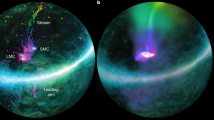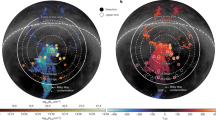Abstract
The first stars in the Universe are predicted to have been much more massive than the Sun1,2,3. Gravitational condensation, accompanied by cooling of the primordial gas via molecular hydrogen, yields a minimum fragmentation scale of a few hundred solar masses. Numerical simulations indicate that once a gas clump acquires this mass it undergoes a slow, quasi-hydrostatic contraction without further fragmentation1,2; lower-mass stars cannot form. Here we show that as soon as the primordial gas—left over from the Big Bang—is enriched by elements ejected from supernovae to a carbon or oxygen abundance as small as ∼0.01–0.1 per cent of that found in the Sun, cooling by singly ionized carbon or neutral oxygen can lead to the formation of low-mass stars by allowing cloud fragmentation to smaller clumps. This mechanism naturally accommodates the recent discovery4 of solar-mass stars with unusually low iron abundances (10-5.3 solar) but with relatively high (10-1.3 solar) carbon abundance. The critical abundances that we derive can be used to identify those metal-poor stars in our Galaxy with elemental patterns imprinted by the first supernovae. We also find that the minimum stellar mass at early epochs is partially regulated by the temperature of the cosmic microwave background.
This is a preview of subscription content, access via your institution
Access options
Subscribe to this journal
Receive 51 print issues and online access
$199.00 per year
only $3.90 per issue
Buy this article
- Purchase on Springer Link
- Instant access to full article PDF
Prices may be subject to local taxes which are calculated during checkout


Similar content being viewed by others
References
Abel, T., Bryan, G. & Norman, M. The formation of the first star in the universe. Science 295, 93–98 (2002)
Bromm, V., Coppi, P. S. & Larson, R. B. The formation of the first stars. I. The primordial star-forming cloud. Astrophys. J. 564, 23–51 (2002)
Nakamura, F. & Umemura, M. The stellar initial mass function in primordial galaxies. Astrophys. J. 569, 549–557 (2002)
Christlieb, N. et al. A stellar relic from the early Milky Way. Nature 419, 904–906 (2002)
McKee, C. F. & Tan, J. C. Massive star formation in 100,000 years from turbulent and pressurized molecular clouds. Nature 416, 59–61 (2002)
Clarke, C. J. & Bromm, V. The characteristic stellar mass as a function of redshift. Mon. Not. R. Astron. Soc. 343, 1224–1230 (2003)
Omukai, K. Protostellar collapse with various metallicities. Astrophys. J. 534, 809–824 (2000)
Bromm, V., Ferrara, A., Coppi, P. S. & Larson, R. B. The fragmentation of pre-enriched primordial objects. Mon. Not. R. Astron Soc. 328, 969–976 (2001)
Schneider, R., Ferrara, A., Natarajan, P. & Omukai, K. First stars, very massive black holes, and metals. Astrophys. J. 571, 30–39 (2002)
Mackey, J., Bromm, V. & Hernquist, L. Three epochs of star formation in the high-redshift universe. Astrophys. J. 586, 1–11 (2003)
Schneider, R., Ferrara, A., Salvaterra, R., Omukai, K. & Bromm, V. Low-mass relics of early star formation. Nature 422, 869–871 (2003)
Heger, A. & Woosley, S. E. The nucleosynthetic signature of population III. Astrophys. J. 567, 532–543 (2002)
Qian, Y.-Z., Sargent, W. L. W. & Wasserburg, G. J. The prompt inventory from very massive stars and elemental abundances in Lyα systems. Astrophys. J. 569, L61–L64 (2002)
Qian, Y.-Z. & Wasserburg, G. J. Determination of nucleosynthetic yields of supernovae and very massive stars from abundances in metal-poor stars. Astrophys. J. 567, 515–531 (2002)
Umeda, H. & Nomoto, K. Nucleosynthesis of zinc and iron peak elements in population III type II supernovae. Astrophys. J. 565, 385–404 (2002)
Sneden, C. & Cowan, J. J. Genesis of the heaviest elements in the Milky Way Galaxy. Science 299, 70–75 (2003)
Umeda, H. & Nomoto, K. First-generation black-hole-forming supernovae and the metal abundance pattern of a very iron-poor star. Nature 422, 871–873 (2003)
Hollenbach, D. & McKee, C. F. Molecule formation and infrared emission in fast interstellar shocks. Astrophys. J. 342, 306–336 (1989)
Tumlinson, J. & Shull, J. M. Zero-metallicity stars and the effects of the first stars on reionization. Astrophys. J. 528, L65–L68 (2000)
Bromm, V., Kudritzki, R. P. & Loeb, A. Generic spectrum and ionization efficiency of a heavy initial mass function for the first stars. Astrophys. J. 552, 464–472 (2001)
Cen, R. The implications of Wilkinson Microwave Anisotropy Probe observations for population III star formation processes. Astrophys. J. 591, L5–L8 (2003)
Sokasian, A., Yoshida, N., Abel, T., Hernquist, L. & Springel, V. Cosmic reionisation by stellar sources: Population III stars. Mon. Not. R. Astron. Soc. (submitted); preprint at 〈http://xxx.lanl.gov/astro-ph/0302213〉 (2003)
Wyithe, J. S. B. & Loeb, A. Was the universe reionized by massive metal-free stars? Astrophys. J. 588, L69–L72 (2003)
Kogut, A. et al. Wilkinson Microwave Anisotropy Probe WMAP first year observations: TE polarization. Astrophys. J. Suppl. 148, 161–173 (2003)
Bromm, V. & Loeb, A. Formation of the first supermassive black holes. Astrophys. J. 596, 34–46 (2003)
Larson, R. B. Early star formation and the evolution of the stellar initial mass function in galaxies. Mon. Not. R. Astron. Soc. 301, 569–581 (1998)
Rees, M. J. Opacity-limited hierarchical fragmentation and the masses of protostars. Mon. Not. R. Astron. Soc. 176, 483–486 (1976)
Bromm, V., Yoshida, N. & Hernquist, L. The first supernova explosions in the universe. Astrophys. J. (in the press); preprint at 〈http://xxx.lanl.gov/astro-ph/0305333〉 (2003)
Akerman, C. J., Carigi, L., Nissen, P. E., Pettini, M. & Asplund, M. The evolution of the C/O ratio in metal-poor halo stars. Astron. Astrophys. (submitted)
Cayrel, R. et al. Abundance patterns and supernova yields in the early Galaxy from C to Zn. Astron. Astrophys. (submitted)
Acknowledgements
We thank R. Barkana and particularly T. Beers for discussions, and are grateful to T. Beers and M. Pettini for making their data available prior to publication. This work was supported in part by NSF, NASA and the Guggenheim foundation (for A.L.).
Author information
Authors and Affiliations
Corresponding authors
Ethics declarations
Competing interests
The authors declare that they have no competing financial interests.
Rights and permissions
About this article
Cite this article
Bromm, V., Loeb, A. The formation of the first low-mass stars from gas with low carbon and oxygen abundances. Nature 425, 812–814 (2003). https://doi.org/10.1038/nature02071
Received:
Accepted:
Issue Date:
DOI: https://doi.org/10.1038/nature02071
This article is cited by
-
Observational signatures of massive black hole formation in the early Universe
Nature Astronomy (2018)
-
Footprints of the weak s-process in the carbon-enhanced metal-poor star ET0097
Astrophysics and Space Science (2016)
-
The numerical frontier of the high-redshift Universe
Computational Astrophysics and Cosmology (2015)
-
Large-Scale Structure Formation: From the First Non-linear Objects to Massive Galaxy Clusters
Space Science Reviews (2015)
-
Outskirts of Galaxy Clusters
Space Science Reviews (2013)
Comments
By submitting a comment you agree to abide by our Terms and Community Guidelines. If you find something abusive or that does not comply with our terms or guidelines please flag it as inappropriate.



